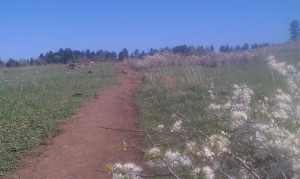 With just 3 weeks to go before my wife Becky and my 3 day, 40 mile run down the Rogue River Trail in Oregon, it’s time to adjust our training strategy. During the week while we’re working, we’ve been continuing a steady dose of daily short runs with one mid-week, mid length run of about 5 miles. On weekends, we’ve been doing at least one long, very difficult run of about 14-15 miles on technical terrain and with 1500 – 2500 feet of elevation gain followed by a 9 or 10 mile run on the second weekend day. This is great training, but we’re finding that the hard run is causing enough strain that the second run on the weekend is lacking in quality because we’re pretty beat up. This level of training would probably have been OK in our 20s but I have to remind myself that we’re in our 50s. Starting this weekend an adjustment is in order.
With just 3 weeks to go before my wife Becky and my 3 day, 40 mile run down the Rogue River Trail in Oregon, it’s time to adjust our training strategy. During the week while we’re working, we’ve been continuing a steady dose of daily short runs with one mid-week, mid length run of about 5 miles. On weekends, we’ve been doing at least one long, very difficult run of about 14-15 miles on technical terrain and with 1500 – 2500 feet of elevation gain followed by a 9 or 10 mile run on the second weekend day. This is great training, but we’re finding that the hard run is causing enough strain that the second run on the weekend is lacking in quality because we’re pretty beat up. This level of training would probably have been OK in our 20s but I have to remind myself that we’re in our 50s. Starting this weekend an adjustment is in order.
We will begin doing a long but easy run on Saturday of about 3 hours (roughly 15 miles) followed by another 2 hour easy run on Sunday. The concept behind this change is that the time we spend on our feet during the long run will benefit our endurance without causing the physical damage to our bodies of the technical terrain with lots of climbing and descending. The 2 hour Sunday will run will also give us a chance to practice running on slightly tired legs which will be likely on the 2nd and 3rd day of the Rogue River Run. We also need some additional nutritional practice with gels during the run. At this point Becky tends to use one gel every 45 minutes to keep her energy up while I either have one gel and the start or none at all. Experimenting with more and less calories will help us to refine to the optimal level. Everyone responds differently to training and nutrition so it’s not expected that we will both arrive at the same optimal levels.
Updates to come in a week or two!



